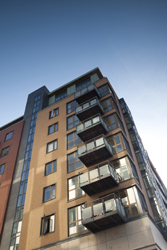Renewable energy from existing high-rise buildings
High-rise buildings have a small roof area compared to their floor area and the roof is often occupied with installations such as cooling towers. In addition, existing buildings usually have a higher energy demand than new ones. The solution to these challenges is to convert the facades of existing buildings into multifunctional elements for harvesting solar energy. A major increase in the number of solar energy components mounted on buildings or integrated into the structure of a building will help the EU achieve its goal of carbon dioxide (CO2) neutrality for the building stock by 2050. The 'Resource and cost-effective integration of renewables in existing high-rise buildings' (COST-EFFECTIVE) project developed five new facade components and systems. Each system was customised according to the building under consideration, taking into consideration size, wind load and safety barrier function. The intention is that the facade components will be produced by local manufacturers on demand, thereby providing an opportunity for European manufacturers in the European market. Consortium members developed a glazing integrated transparent solar thermal collector and air-heating vacuum tube collectors for facade application. Project partners also developed an angle-selective transmittance building-integrated photovoltaic (BIPV) component. In addition, a facade-integrated natural ventilation system with heat recovery was created together with a solar-assisted decentralised heat pump system that used unglazed solar thermal collectors with plaster covering. Researchers also combined technical concepts and corresponding business models for the most important categories of existing high-rise buildings in Europe. The new business and cost models considered the whole life cycle of a building and incorporated the benefits from reduced running costs and greenhouse gas emissions. The consortium also demonstrated the practical feasibility of their work in two pilot buildings, one in Spain and the other in Slovenia. Work conducted by the COST-EFFECTIVE consortium will help increase the uptake of renewable technology for heating and cooling Europe's existing high-rise buildings and ensure that the 2050 CO2 neutrality target is met.







